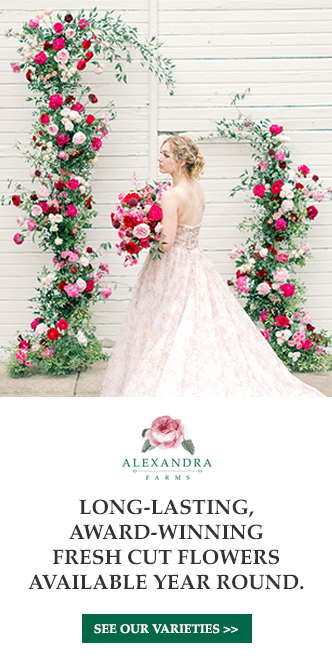The exit strategy every florist needs.
By Kat Castagnoli, AIFD
For many florists, retirement planning isn’t just low on the priority list—it often doesn’t exist at all. Long hours, tight margins and a culture that celebrates artistry over financial strategy make it easy to focus on the next big event instead of the next 20 years. Diana Culver knows the risks of that mindset firsthand.
Her parents opened Magnolia Florist in San Diego in 1983 and ran multiple shops for nearly two decades. “Every dollar went back into rent, overhead, flowers and supplies,” she recalls. “They never owned their building. When the businesses closed, they had nothing to fall back on. My father passed away while still renting their home, and my mother doesn’t have the retirement she imagined.”
Culver followed in their footsteps, launching Fleur D’Lis Flowers in 2009. By her late twenties, she was on track toward AIFD certification and local success. But then at 29, a breast cancer diagnosis changed everything.
“On chemo weeks and after surgeries, I couldn’t work,” she says. “Because I hadn’t built other income streams or hired staff to keep things going, there was nothing to cover the gaps. The pressure was enormous.”
That experience forced her to step away from floral design and rethink her future. “I realized I was working so hard and had nothing to show for it,” Culver explains. “I didn’t see a clear path to long-term security in flowers. That missing piece led me into real estate—and to my mission now of helping florists prepare smarter than I did.”
Why Real Estate Creates Stability
For Culver, real estate is the game-changer. “Ownership equals options,” she says. “When you rent, you’re at the mercy of landlords. When you own, you control the space, the income and the future.”
That ownership can take many forms: buying your shop’s building, investing in a duplex or condo to rent out or transforming part of your shop into an event space. “If I had even one rental property back then, that income could have carried me through my treatment,” she reflects.
Comerica’s small-business retirement guide emphasizes that entrepreneurs often neglect asset-building outside their business, leaving them vulnerable when sales decline. It also notes that diversification—through real estate, investments and retirement accounts—protects owners from relying solely on their shop as a retirement plan.
Rethinking Exit Strategies
Florists who dream of retiring often assume they’ll simply sell their shop someday. But that’s not always realistic. “Most shops are so tied to the owner’s artistry that they’re hard to sell for top dollar,” Culver explains.
Other options include:
- Gradual succession: Mentoring a younger designer or employee to take over, sometimes through what’s called the “Golden Handshake,” where the original owner transitions clients over two to five years.
- Partnerships or acquisitions: Inviting a trusted employee, peer or related business to take on leadership and eventually ownership.
- Building outside assets: Securing real estate or other investments that generate income, regardless of whether the shop sells.
Exit planners stress that preparing years in advance—by documenting systems, valuing the business and creating a succession timeline—dramatically improves outcomes. Without that preparation, too many florists close after decades with nothing but leftover supplies.
Practical First Steps
So where should florists start? Culver and finance experts alike suggest the following moves:
- Take an honest inventory: Do you own or rent your shop and home? What equity could you leverage?
- Open a retirement account: SEP IRAs, SIMPLE IRAs or solo 401(k)s can provide tax benefits and growth opportunities, even with modest contributions.
- Embed savings into pricing: “If I could do it over again, I would have built retirement costs into every design, delivery fee and consultation,” Culver says.
- Consult professionals: Certified public accountants (CPAs) and fiduciary advisers can help structure business income, create retirement vehicles and identify property opportunities.
- Systemize your business: Buyers and successors want to see a business that can run without you. Documenting revenue streams and processes now is critical.
“Business owners must separate personal wealth-building from day-to-day cash flow,” notes Fulton Bank’s small-business retirement guide. “Otherwise, retirement is always at risk of collapse with the business.”
Redefining Legacy
For florists who want to pass their shops down, Culver urges intentionality. “Training a successor takes years. Decide whether you want your name and style to live on or whether the brand continues in another form.”
But she also reframes legacy in broader terms: “Passing down a building, a rental property or even a multi-use space is just as valuable as passing down a shop. It gives the next generation incentive and stability.”
A Stronger Industry
Culver imagines a flower industry where conversations about money are as common as conversations about Ranunculus or roses. “I want to see florists proud not just of their artistry, but of their assets,” she says. “I want shops that generate multiple streams of income and designers who get to keep designing or retire because they choose to.”
Financial advisers echo that vision. They recommend integrating retirement into business planning from day one. They also emphasize that diversifying assets is no longer optional—it’s essential.
“I picture a future where the next generation of florists doesn’t just inherit the beauty of this industry, but the stability of it too,” Culver concludes. “We can rise up now, plan smarter and prove that florists deserve not only admiration for their work, but respect for their financial futures.”
5 Retirement Steps Florists Can Take Right Now
- Run a Reality Check
Make a list: Do you own or rent your shop? Own or rent your home? What’s your equity position?
- Open a Retirement Account
Even small contributions to a SEP IRA, SIMPLE IRA or solo 401(k) create tax advantages and build long-term discipline.
- Price for Your Future
Add a few dollars into consultation fees, delivery charges or design pricing— earmarked for retirement savings.
- Talk to Your CPA
A trusted CPA or fiduciary adviser can help you leverage profits, plan for real estate purchases and set up proper accounts.
- Create a Successor File
Document your client list, processes and vendor contacts. A shop that runs without you is more valuable—and more sellable.























